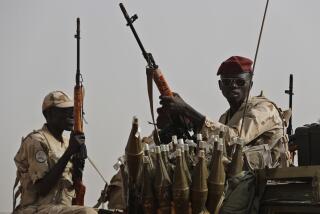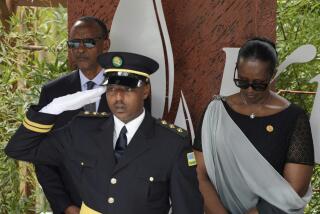Rotting Bodies, Ghost Towns Dot Rwanda : Africa: Survivors tell of slaughter by militias. Shelling again closes airport to relief flights.
BIRENGA, Rwanda — A scavenger bird with a sharp orange beak pecked at the ribs of a man who died in a roadside ditch. The bird flew off and landed for a moment near the sunbaked remains of a baby girl wrapped in a dirty flowered shawl.
The bird squawked once and flew away again. The village was silent. The people who once called it home are dead or gone.
Across rebel-held southeastern Rwanda such scenes make up the apocalyptic landscape: rotting bodies, ghost towns, hungry-eyed refugees resting in the shade of looted stores.
The rebel Rwandan Patriotic Front says the massacres and destruction were the work of government-allied militias, driven back toward the center of the country weeks ago. Foreigners have just begun to tour the area.
It is impossible to verify who was responsible for the slaughters, but those who escaped say it was militiamen from the majority Hutu tribe who attacked with the intent of leaving no survivors.
Tutsis--the minority tribe leading the rebel movement--were the main target, survivors said. But any villages resisting the militias or considered sympathetic to the rebels were hit, they said.
“The militias came through town yelling, ‘We are going to exterminate you,’ ” said Dominic Mborombago, a member of the Hutu tribe from the village of Rusumo near the border. “I ran into the forest, but was caught in an ambush. They thought I was dead and left.”
The blood bath began last month after the Hutu presidents of Rwanda and neighboring Burundi were killed in a mysterious plane crash on April 6.
On Friday, rebel artillery and mortars outside the capital, Kigali, pounded government positions near the airport, closing Rwanda’s main link to the outside world to relief flights for a second straight day.
U.N. officials and aid workers believe at least 200,000 people have been killed, mostly Tutsi civilians, since fighting broke out last month. Some estimates are as high as 500,000. At least 2 million people have fled to escape the slaughter.
Mborombago said he was slashed in the head and leg with a machete April 14, eight days after the civil war erupted. His leg gash has festered and swelled with infection. He was finally taken to a hospital in Gahini, 35 miles northwest, on Wednesday to join the nearly 400 other patients recovering from machete and gunshot wounds. Rebel forces guard the compound.
In the children’s wing, a young girl winced when she tried to put pressure on her machete-hacked ankle. A few children with similar wounds sat on dirty burlap and played with plastic blocks.
An orphan boy tugged on the arm of a foreigner. “Take me with you,” he begged. “Take me with you.”
“You can’t go,” said a nurse. “This is your home for the time being.”
The boy’s true home--and the bodies of his parents--lie seven miles up a dirt road. Sometime around April 10, the villagers of Rukara took refuge in the Roman Catholic church. The rebels charge that government militias blasted the church with grenades then finished off those who tried to flee with guns, machetes and spears. Few escaped. The rebels say thousands died.
More to Read
Sign up for Essential California
The most important California stories and recommendations in your inbox every morning.
You may occasionally receive promotional content from the Los Angeles Times.










